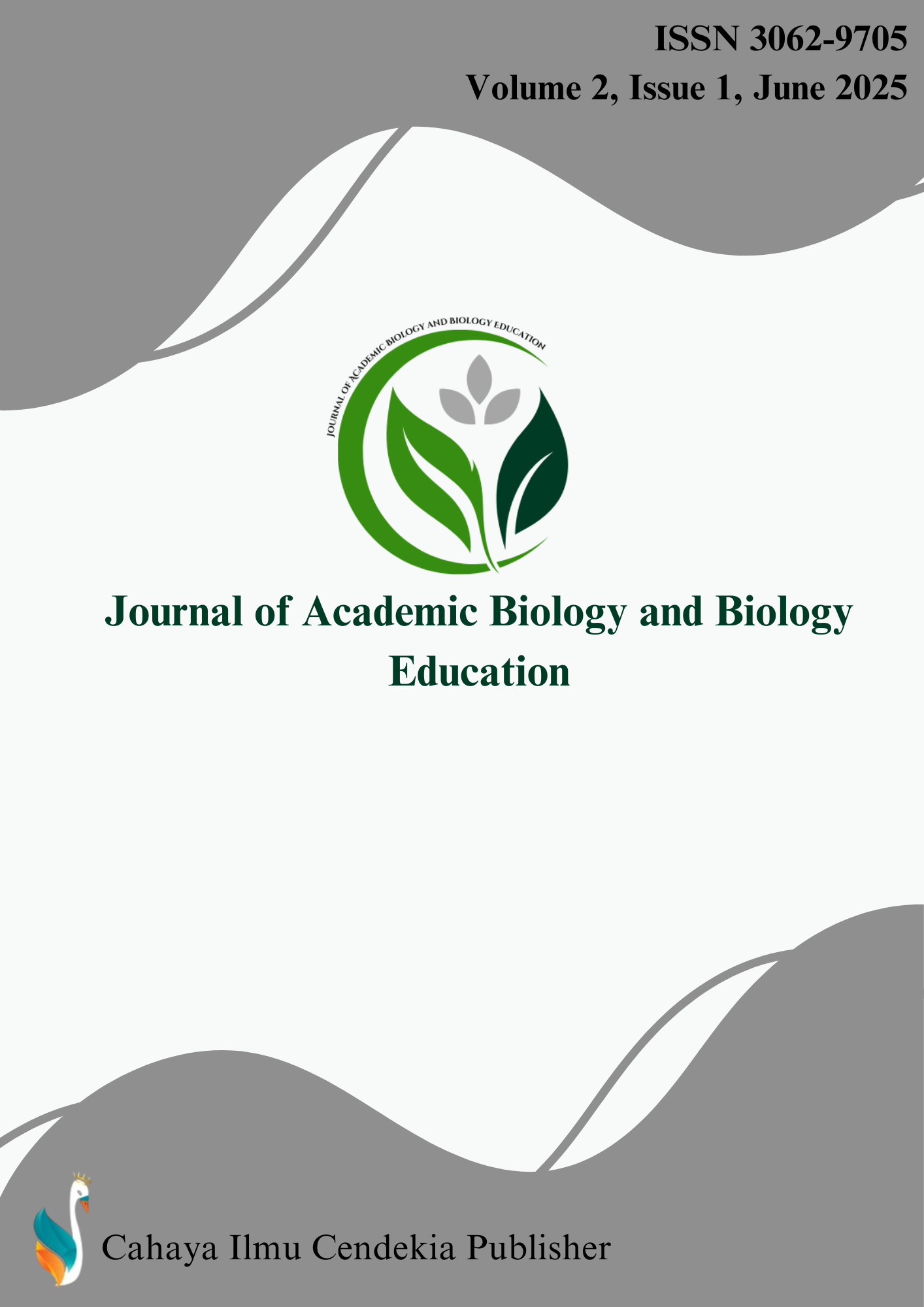Evaluation of Curcumin as NF-κB Inhibitor for Breast Cancer Therapy Using in Silico Approach
Abstract
Purpose of the study: This study aims to evaluate the potential of curcumin as a breast cancer therapeutic agent by analyzing its ability to inhibit NF-κB activation using an in silico approach, specifically through molecular docking to assess absorption and interaction with the target protein.
Methodology: This study used a quantitative experimental method with molecular docking as an in silico approach. Tools included a Lenovo laptop (Intel® Inside™, Windows 10 Pro). Software used: PyRx 0.8 (with AutoDock Vina), YASARA, PyMOL, and Discovery Studio 2019. Ligand data were obtained from PubChem; protein from Protein Data Bank. Lipinski’s Rule was applied for drug-likeness screening.
Main Findings: Curcumin showed a binding affinity of -6.2 kcal/mol to NF-κB with RMSD < 2.00 Å. Visualization confirmed hydrogen bonds at ASN 32 and ASN 47, and hydrophobic pi-alkyl interactions at ALA 34 and ARG 50. Lipinski’s Rule of Five was fulfilled, indicating good oral drug-likeness and potential as an NF-κB inhibitor in breast cancer therapy.
Novelty/Originality of this study: This study offers new insights into the potential of curcumin as a natural NF-κB inhibitor for breast cancer therapy through a comprehensive in silico approach. By combining molecular docking, visualization, and drug-likeness analysis, it advances current knowledge by highlighting curcumin’s binding efficiency and pharmacological feasibility, supporting its development as an alternative anticancer candidate.
References
H. Sung et al., “Global cancer statistics 2020: GLOBOCAN estimates of incidence and mortality worldwide for 36 cancers in 185 countries,” CA. Cancer J. Clin., vol. 71, no. 3, pp. 209–249, May 2021, doi: 10.3322/caac.21660.
J. Ferlay et al., “Estimating the global cancer incidence and mortality in 2018: GLOBOCAN sources and methods,” Int. J. Cancer, vol. 144, no. 8, pp. 1941–1953, Apr. 2019, doi: 10.1002/ijc.31937.
R. L. Siegel, T. B. Kratzer, A. N. Giaquinto, H. Sung, and A. Jemal, “Cancer statistics, 2025.,” CA. Cancer J. Clin., no. October 2024, pp. 10–45, 2025, doi: 10.3322/caac.21871.
Z. Li et al., “Global landscape of cervical cancer incidence and mortality in 2022 and predictions to 2030: the urgent need to address inequalities in cervical cancer,” Int. J. Cancer, vol. 157, no. 2, pp. 288–297, Jul. 2025, doi: 10.1002/ijc.35369.
W. Cao, K. Qin, F. Li, and W. Chen, “Comparative study of cancer profiles between 2020 and 2022 using global cancer statistics (GLOBOCAN),” J. Natl. Cancer Cent., vol. 4, no. 2, pp. 128–134, Jun. 2024, doi: 10.1016/j.jncc.2024.05.001.
A. K. Das, S. K. Biswas, A. Bhattacharya, and E. Alam, “Introduction to breast cancer and awareness,” in 2021 7th International Conference on Advanced Computing and Communication Systems (ICACCS), IEEE, Mar. 2021, pp. 227–232. doi: 10.1109/ICACCS51430.2021.9441686.
M. cancer is caused by the proliferation of abnormal cells in breast tissue that form a lumphammad Akram, M. Iqbal, M. Daniyal, and A. U. Khan, “Awareness and current knowledge of breast cancer,” Biol. Res., vol. 50, no. 1, pp. 1–23, 2017, doi: 10.1186/s40659-017-0140-9.
R. L. Siegel, K. D. Miller, H. E. Fuchs, and A. Jemal, “Cancer statistics, 2021,” CA. Cancer J. Clin., vol. 71, no. 1, pp. 7–33, Jan. 2021, doi: 10.3322/caac.21654.
J. Lopiccolo, A. Gusev, D. C. Christiani, and P. A. Jänne, “Lung cancer in patients who have never smoked — an emerging disease,” Nat Rev Clin Oncol, vol. 21, no. 2, pp. 121–146, 2024, doi: 10.1038/s41571-023-00844-0.Lung.
S. Łukasiewicz, M. Czeczelewski, A. Forma, J. Baj, R. Sitarz, and A. Stanisławek, “Breast cancer—epidemiology, risk factors, classification, prognostic markers, and current treatment strategies—an updated review,” Cancers (Basel)., vol. 13, no. 17, p. 4287, Aug. 2021, doi: 10.3390/cancers13174287.
M. T. Kabir et al., “Potential role of curcumin and its nanoformulations to treat various types of cancers,” Biomolecules, vol. 11, no. 3, pp. 1–39, 2021, doi: 10.3390/biom11030392.
D. Korbie et al., “Immunomodulatory gene networks predict treatment response and survival to de-escalated, anthracycline-free neoadjuvant chemotherapy in triple-negative breast cancer in the WSG-ADAPT-TN trial,” Mol. Cancer, vol. 24, no. 1, 2025, doi: 10.1186/s12943-025-02275-0.
M. S. Al-Mutairi and H. O. Habashy, “Nuclear Factor-κB clinical significance in breast cancer: an immunohistochemical study,” Med. Princ. Pract., vol. 32, no. 1, pp. 33–39, 2023, doi: 10.1159/000527828.
Y. Ding and Q. Chen, “The NF-κB pathway: a focus on inflammatory responses in spinal cord injury,” Mol. Neurobiol., vol. 60, no. 9, pp. 5292–5308, 2023, doi: 10.1007/s12035-023-03411-x.
T. Zhang, C. Ma, Z. Zhang, H. Zhang, and H. Hu, “NF-κB signaling in inflammation and cancer,” MedComm, vol. 2, no. 4, pp. 618–653, 2021, doi: 10.1002/mco2.104.
Q. Cao, X. Q. Ai, and M. Mushajiang, “Significance of nuclear factor-kappa B (NF-κB) and survivin in breast cancer and their association with radiosensitivity and prognosis,” Breast Cancer Targets Ther., vol. 15, pp. 175–188, 2023, doi: 10.2147/BCTT.S399994.
K. S. Alharbi et al., “Nuclear factor-kappa B and its role in inflammatory lung disease,” Chem. Biol. Interact., vol. 345, p. 109568, Aug. 2021, doi: 10.1016/j.cbi.2021.109568.
B. George, T. V. Suchithra, and N. Bhatia, “Burn injury induces elevated inflammatory traffic: the role of NF-κB,” Inflamm. Res., vol. 70, no. 1, pp. 51–65, Jan. 2021, doi: 10.1007/s00011-020-01426-x.
L. Barnabei, E. Laplantine, W. Mbongo, F. Rieux-Laucat, and R. Weil, “NF-κB: At the borders of autoimmunity and inflammation,” Front. Immunol., vol. 12, no. August, pp. 1–27, 2021, doi: 10.3389/fimmu.2021.716469.
S. Almowallad, L. S. Alqahtani, and M. Mobashir, “NF-kB in signaling patterns and its temporal dynamics encode/decode human diseases,” Life, vol. 12, no. 12, p. 2012, Dec. 2022, doi: 10.3390/life12122012.
M. Pakjoo et al., “Interplay between proteasome inhibitors and NF-κB pathway in leukemia and lymphoma: a comprehensive review on challenges ahead of proteasome inhibitors,” Cell Commun. Signal. , vol. 22, no. 1, pp. 1–28, 2024, doi: 10.1186/s12964-023-01433-5.
S. Bacher, J. Meier-Soelch, M. Kracht, and M. L. Schmitz, “Regulation of transcription factor nf-κb in its natural habitat: The nucleus,” Cells, vol. 10, no. 4, 2021, doi: 10.3390/cells10040753.
M. Antunes-Ricardo, T. De Monterrey, M. Reviewed, J. Fernando Ayala-Zavala, S. S. Saldivar, and K. O. Ajanaku, “Functional bioactive compounds in ginger, turmeric, and garlic,” Front. Nutr., no. 3, 2022.
M. Roney, A. K. M. M. Huq, K. Rullah, N. B. Zamri, and M. F. F. Mohd Aluwi, “Curcumin, a bioactive compound of Turmeric (Curcuma longa) and its derivatives as α-amylase and α-glucosidase inhibitors,” Cell Biochem. Biophys., vol. 83, no. 1, pp. 53–71, Aug. 2024, doi: 10.1007/s12013-024-01477-5.
A. N. Jikah and G. I. Edo, “Turmeric (Curcuma longa): an insight into its food applications, phytochemistry and pharmacological properties,” Vegetos, vol. 38, no. 3, pp. 845–866, Sep. 2024, doi: 10.1007/s42535-024-01038-4.
B. C. Okoro et al., “The ethnobotanical, bioactive compounds, pharmacological activities and toxicological evaluation of garlic (Allium sativum): A review,” Pharmacol. Res. - Mod. Chinese Med., vol. 8, p. 100273, Sep. 2023, doi: 10.1016/j.prmcm.2023.100273.
Z. Zhang et al., “Polyphenols as plant-based nutraceuticals: health effects, encapsulation, nano-delivery, and application,” Foods, vol. 11, no. 15, p. 2189, Jul. 2022, doi: 10.3390/foods11152189.
D. O. Moon, “Curcumin in cancer and inflammation: an in-depth exploration of molecular interactions, therapeutic potentials, and the role in disease management,” Int. J. Mol. Sci., vol. 25, no. 5, 2024, doi: 10.3390/ijms25052911.
M. Mohamadian, A. Bahrami, M. Moradi Binabaj, F. Asgharzadeh, and G. A. Ferns, “Molecular targets of curcumin and its therapeutic potential for ovarian cancer,” Nutr. Cancer, vol. 74, no. 8, pp. 2713–2730, Sep. 2022, doi: 10.1080/01635581.2022.2049321.
Y. Chang, B. A. Hawkins, J. J. Du, P. W. Groundwater, D. E. Hibbs, and F. Lai, “A guide to in silico drug design,” Pharmaceutics, vol. 15, no. 1, p. 49, Dec. 2022, doi: 10.3390/pharmaceutics15010049.
D. Gomes et al., “In silico approaches: a way to unveil novel therapeutic drugs for cervical cancer management,” Pharmaceuticals, vol. 14, no. 8, p. 741, Jul. 2021, doi: 10.3390/ph14080741.
R. N. Ram, D. Gadaleta, and T. E. H. Allen, “The role of ‘big data’ and ‘in silico’ New Approach Methodologies (NAMs) in ending animal use – a commentary on progress,” Comput. Toxicol., vol. 23, p. 100232, Aug. 2022, doi: 10.1016/j.comtox.2022.100232.
H. J. Huang, Y. H. Lee, Y. H. Hsu, C. Te Liao, Y. F. Lin, and H. W. Chiu, “Current strategies in assessment of nanotoxicity: alternatives to in vivo animal testing,” Int. J. Mol. Sci., vol. 22, no. 8, 2021, doi: 10.3390/ijms22084216.
F. Stanzione, I. Giangreco, and J. C. Cole, “Use of molecular docking computational tools in drug discovery,” 2021, pp. 273–343. doi: 10.1016/bs.pmch.2021.01.004.
L. Ivanova and M. Karelson, “The impact of software used and the type of target protein on molecular docking accuracy,” Molecules, vol. 27, no. 24, p. 9041, Dec. 2022, doi: 10.3390/molecules27249041.
H. J. Pentury, “Pengembangan kreativitas guru dalam pembelajaran kreatif pelajaran Bahasa Inggris,” Fakt. J. Ilm. Kependidikan, vol. 4, no. 3, pp. 265–272, 2017, doi: 10.30998/fjik.v4i3.1923.
R. Bhowmik et al., “Navigating bioactivity space in anti-tubercular drug discovery through the deployment of advanced machine learning models and cheminformatics tools: a molecular modeling based retrospective study,” Front. Pharmacol., vol. 14, no. August, pp. 1–21, 2023, doi: 10.3389/fphar.2023.1265573.
R. Farghadani and R. Naidu, “Curcumin: modulator of key molecular signaling pathways in hormone-independent breast cancer,” Cancers (Basel)., vol. 13, no. 14, p. 3427, Jul. 2021, doi: 10.3390/cancers13143427.
S. S. Panda et al., “Design, synthesis, and molecular docking studies of curcumin hybrid conjugates as potential therapeutics for breast cancer,” Pharmaceuticals, vol. 15, no. 4, p. 451, Apr. 2022, doi: 10.3390/ph15040451.
A. Tiwari, M. Singh, and B. Sahu, “Risk factors for breast cancer,” Int. J. Nurs. Educ. Res., pp. 276–282, Aug. 2022, doi: 10.52711/2454-2660.2022.00065.
K. Deka and Y. Li, “Transcriptional regulation during aberrant activation of NF-κB signalling in cancer,” Cells, vol. 12, no. 5, pp. 1–24, 2023, doi: 10.3390/cells12050788.
M. Shahbaz et al., “Curcumin: a bioactive compound with molecular targets for human malignancies,” Food Agric. Immunol., vol. 34, no. 1, 2023, doi: 10.1080/09540105.2023.2280524.
D. Dey et al., “Natural flavonoids effectively block the CD81 receptor of hepatocytes and inhibit HCV infection: a computational drug development approach,” Mol. Divers., vol. 27, no. 3, pp. 1309–1322, Jun. 2023, doi: 10.1007/s11030-022-10491-9.
S. H. Abdullahi et al., “Molecular docking studies of some benzoxazole and benzothiazole derivatives as VEGFR-2 target inhibitors: In silico design, MD simulation, pharmacokinetics and DFT studies,” Intell. Pharm., vol. 2, no. 2, pp. 232–250, Apr. 2024, doi: 10.1016/j.ipha.2023.11.010.
D. Yusuf, A. M. Davis, G. J. Kleywegt, and S. Schmitt, “An alternative method for the evaluation of docking performance: RSR vs RMSD,” J. Chem. Inf. Model., vol. 48, no. 7, pp. 1411–1422, Jul. 2008, doi: 10.1021/ci800084x.
O. Alkhamis, C. Byrd, J. Canoura, A. Bacon, R. Hill, and Y. Xiao, “Exploring the relationship between aptamer binding thermodynamics, affinity, and specificity,” Nucleic Acids Res., vol. 53, no. 6, 2025, doi: 10.1093/nar/gkaf219.
C. A. Lipinski, “Drug-like properties and the causes of poor solubility and poor permeability,” J. Pharmacol. Toxicol. Methods, vol. 44, no. 1, pp. 235–249, 2000, doi: 10.1016/S1056-8719(00)00107-6.
B. Chandrasekaran et al., “Drug-receptor interactions,” P. Kumar and P. K. Deb, Eds., Singapore: Springer Singapore, 2020, pp. 31–68. doi: 10.1007/978-981-15-3556-7_2.
P. Rajak and A. Ganguly, “The ligand-docking approach explores the binding affinity of PFOS and PFOA for major endogenous antioxidants: a potential mechanism to fuel oxidative stress,” Sustain. Chem. Environ., vol. 4, p. 100047, Dec. 2023, doi: 10.1016/j.scenv.2023.100047.
D. Chen, N. Oezguen, P. Urvil, C. Ferguson, S. M. Dann, and T. C. Savidge, “Regulation of protein-ligand binding affinity by hydrogen bond pairing.,” Sci. Adv., vol. 2, no. 3, p. e1501240, Mar. 2016, doi: 10.1126/sciadv.1501240.
M. Putri, F. Israyusnita, M. S. S. Ramadhan, and R. Wiranata, “Optimasi afinitas flavonoid dan antrakuinon dari mengkudu (Morinda citrifolia Linn.) terhadap ACE-1 sebagai solusi antihipertensi [Optimization of the affinity of flavonoids and anthraquinones from noni (Morinda citrifolia Linn.) against ACE-1 as an antih,” Researchgate.Net, no. October, 2021, [Online]. Available: https://www.researchgate.net/profile/Alfi_Maghfirah/publication/355779827_Optimasi_Afinitas_Flavonoid_dan_Antrakuinon_dari_Mengkudu_Morinda_citrifolia_Linn_Terhadap_ACE-1_sebagai_Solusi_Antihipertensi/links/617d68863c987366c3065409/Optimasi-Afinitas-Flavo
Copyright (c) 2025 Endang Adillah, Nour Albahri, Shrouk Ekramy

This work is licensed under a Creative Commons Attribution 4.0 International License.
Authors who publish with this journal agree to the following terms:
- Authors retain copyright and acknowledge that the Journal of Academic Biology and Biology Education is the first publisher licensed under a Creative Commons Attribution 4.0 International License.
- Authors are able to enter into separate, additional contractual arrangements for the non-exclusive distribution of the journal's published version of the work (e.g., post it to an institutional repository or publish it in a book), with an acknowledgment of its initial publication in this journal.
- Authors are permitted and encouraged to post their work online (e.g., in institutional repositories or on their website) prior to and during the submission process, as it can lead to productive exchanges and earlier and greater citation of published work.



.png)

.png)
.png)








